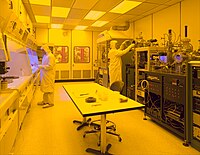
Characterization and Quantification of Depletion and Accumulation Layers in Solid-State Li+ -Conducting Electrolytes Using In Situ Spectroscopic Ellipsometry.
Sign Up to like & getrecommendations! Published in 2021 at "Advanced materials"
DOI: 10.1002/adma.202100585
Abstract: The future of mobility depends on the development of next-generation battery technologies, such as all-solid-state batteries. As the ionic conductivity of solid Li+ -conductors can, in some cases, approach that of liquid electrolytes, a significant… read more here.
Keywords: solid state; state; accumulation; spectroscopic ellipsometry ... See more keywords

Swelling Process of Thin Polymer Film Studied via in situ Spectroscopic Ellipsometry
Sign Up to like & getrecommendations! Published in 2017 at "Chemical Research in Chinese Universities"
DOI: 10.1007/s40242-017-7075-0
Abstract: The swelling process of thin polystyrene films in quantity was studied in this paper using the in situ spectroscopic ellipsometry. We systematically investigated the influence of film thickness on the swelling process of thin polystyrene… read more here.
Keywords: spectroscopic ellipsometry; process; swelling process; process thin ... See more keywords

Spectroscopic Ellipsometry of Asphalt Binder: A Study of Optical Constants
Sign Up to like & getrecommendations! Published in 2019 at "International Journal of Civil Engineering"
DOI: 10.1007/s40999-019-00468-5
Abstract: Spectroscopic ellipsometry is a powerful technique for determining optical properties of any thin surface. A method for characterizing optical properties of warm asphalt binder using spectroscopic ellipsometry along with associated results has been presented in… read more here.
Keywords: coefficient; ellipsometry; asphalt binder; spectroscopic ellipsometry ... See more keywords

Characterization of thin SiGe layers on Si (001) by spectroscopic ellipsometry for Ge fractions from 0 to 100
Sign Up to like & getrecommendations! Published in 2017 at "Applied Surface Science"
DOI: 10.1016/j.apsusc.2016.08.091
Abstract: Abstract We report on the investigation of thin, epitaxially grown Si 1- x Ge x layers on Si(001) substrates by spectroscopic ellipsometry over the entire composition range. Si 1-x Ge x layers with Ge fractions… read more here.
Keywords: layers 001; sige layers; spectroscopic ellipsometry; thin sige ... See more keywords

Optical properties of thickness-controlled MoS 2 thin films studied by spectroscopic ellipsometry
Sign Up to like & getrecommendations! Published in 2017 at "Applied Surface Science"
DOI: 10.1016/j.apsusc.2016.09.069
Abstract: Abstract As a promising candidate for applications in future electronic and optoelectronic devices, MoS 2 has been a research focus in recent years. Therefore, investigating its optical properties is of practical significance. Here we synthesized… read more here.
Keywords: thin films; spectroscopic ellipsometry; optical properties; mos thin ... See more keywords

Atomic Force Microscopy and Spectroscopic Ellipsometry combined analysis of Small Ubiquitin-like Modifier adsorption on functional monolayers
Sign Up to like & getrecommendations! Published in 2017 at "Applied Surface Science"
DOI: 10.1016/j.apsusc.2016.10.195
Abstract: Abstract The comprehension of mechanisms of interaction between functional layers and proteins is relevant for the development of sensitive and precise biosensors. Here we report our study which combines Atomic Force Microscopy and Spectroscopic Ellipsometry… read more here.
Keywords: spectroscopic ellipsometry; microscopy; small ubiquitin; force microscopy ... See more keywords

Optical properties of InP from infrared to vacuum ultraviolet studied by spectroscopic ellipsometry
Sign Up to like & getrecommendations! Published in 2017 at "Applied Surface Science"
DOI: 10.1016/j.apsusc.2017.01.027
Abstract: Abstract The optical properties of an epitaxial indium phosphide (InP) film deposited on an Fe compensated InP (InP:Fe) wafer have been measured at room temperature by ex-situ spectroscopic ellipsometry over a spectral range of 0.038–8.5 eV.… read more here.
Keywords: properties inp; optical properties; inp infrared; spectroscopic ellipsometry ... See more keywords

Optical constants of electroplated gold from spectroscopic ellipsometry
Sign Up to like & getrecommendations! Published in 2017 at "Applied Surface Science"
DOI: 10.1016/j.apsusc.2017.03.126
Abstract: Abstract The optical constants of an opaque electroplated gold film (Laser Gold from Epner Technology Inc.), were determined by spectroscopic ellipsometry at room temperature over the spectral range from 0.142 μm in the vacuum ultraviolet to… read more here.
Keywords: spectroscopic ellipsometry; optical constants; surface; model ... See more keywords

Infrared spectroscopic ellipsometry of micrometer-sized SiO 2 line gratings
Sign Up to like & getrecommendations! Published in 2017 at "Applied Surface Science"
DOI: 10.1016/j.apsusc.2017.04.118
Abstract: Abstract For the design and process control of periodic nano-structured surfaces spectroscopic ellipsometry is already established in the UV–VIS spectral regime. The objective of this work is to show the feasibility of spectroscopic ellipsometry in… read more here.
Keywords: ellipsometry; line gratings; micrometer sized; spectroscopic ellipsometry ... See more keywords

Determination of conductivity anisotropy and the role of doping in single walled carbon nanotube thin films with THz spectroscopic ellipsometry
Sign Up to like & getrecommendations! Published in 2018 at "Carbon"
DOI: 10.1016/j.carbon.2017.12.022
Abstract: Abstract Wide spectral range spectroscopic ellipsometry (SE) measurements spanning from the THz to the UV (0.41 meV–5.9 eV) are taken of a single walled carbon nanotube thin film while in both undoped and nitric acid doped states.… read more here.
Keywords: spectroscopic ellipsometry; walled carbon; carbon nanotube; single walled ... See more keywords

Non-destructive characterization of corroded glass surfaces by spectroscopic ellipsometry
Sign Up to like & getrecommendations! Published in 2018 at "Journal of Non-crystalline Solids"
DOI: 10.1016/j.jnoncrysol.2017.10.054
Abstract: Abstract Characterization of the alteration layers that form on glass surfaces during corrosion processes provides valuable information on both the mechanisms and rate of glass alteration. In recent years, state-of-the-art materials and surface characterization techniques… read more here.
Keywords: spectroscopic ellipsometry; glass; non destructive; alteration ... See more keywords